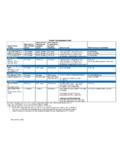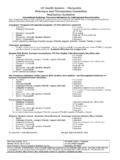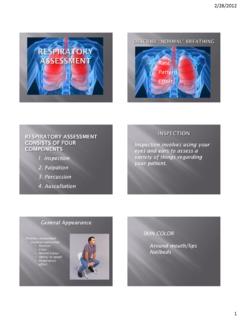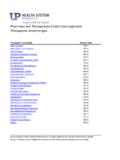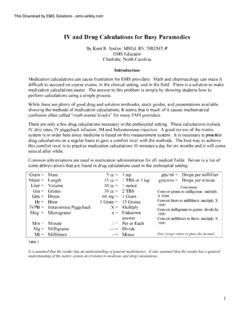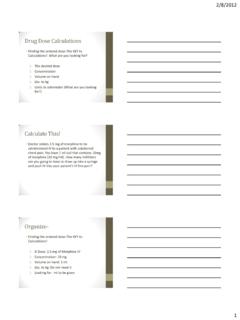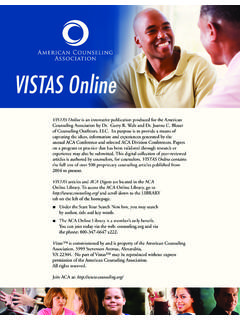Transcription of Trauma and Attachment - Marquette General Hospital
1 Trauma AND. Attachment . Heather Busser-DeMarte, PsyD. Clinical Psychologist Objectives Attendees will be able to: Understand the healthy development of child-caregiver Attachment Identify and understand the various Attachment styles Identify different types of Trauma , including acute Trauma , chronic Trauma , and complex Trauma . Increase understanding of how Trauma impacts Attachment in children and adolescents Understand Trauma /stressor related Attachment disorders from DSM5, including reactive Attachment disorder and disinhibited social engagement disorder Discuss treatment approaches for addressing Trauma ( , Trauma - Focused Cognitive Behavioral Therapy). What is Attachment ? Attachment is the emotional relationship between a child and the regular caregiver . APA Online Psychology Matters: Glossary John Bowlby Father of Attachment Theory Attachment work really began to take shape in the 1950's John Bowlby was the first Attachment theorist, describing Attachment as a "lasting psychological connectedness between human beings.
2 ". Bowlby believed that the earliest bonds formed by children with their caregivers have a tremendous impact that continues throughout life. Attachment Types Mary Ainsworth expanded on Bowlby's work In the 1970s, Ainsworth devised a procedure called a "Strange situation", to observe Attachment relationships between a caregiver and child. On the basis of their behaviors, the children were categorized into three groups, with a fourth added later. Each of these groups reflects a different kind of Attachment relationship with the caregiver. Secure Attachment Parenting styles related to secure Attachment : Consistently respond to needs Respond in a loving/caring way Feeds hungry child in timely manner Comforts child when scared, nervous, upset Joins child in his/her excitement. As children: Child feels he/she can depend on parent/caregiver Child usually plays well with other children May cry when parent leaves but will settle down if a friendly adult is there to comfort Happy to see parent(s) when they return Child learns that he/she can trust and rely on caring adults As adults Has trusting, lasting relationships Tend to have high self-esteem, better self-reliance Are comfortable sharing feelings Seek out social support May experience less depression and anxiety Avoidant Attachment Parenting styles related to avoidant Attachment : May respond to needs, but not in a timely fashion Child may wait a lot time to be fed Fear is dealt with alone Parent does not share in child's excitement As children.
3 Have learned that depending on parents won't get them the secure feeling they want These children may learn to take care of themselves May be too independent, won't ask for help, but get frustrated May have peer relational problems and may be aggressive at times Usually do not build strong relationships with other providers ( , daycare). Don't seem to mind when parents leave, don't seem happy when parents return; May even seem to ignore parents As adults: May have intimacy problems Do not invest much in relationships Unwilling/unable to share feelings with others Ambivalent Attachment Parenting styles related to ambivalent Attachment : Parents sometimes respond to crying infant and sometimes do not May feed a hungry child, but may feed the child when not hungry May overly comfort a scared child, other times may ignore Doesn't understand a child's excitement or responds inappropriately As children: Ambivalence = not sure.
4 Sometimes needs are met, and sometimes they are not Child is always looking for that feeling of security ( , may behave inappropriately because the behavior consistently gets parent's attention). Clingy Immature and over-emotional, baby talk Attention-seeking Will latch onto everyone for short periods of time; Wary of strangers Hard letting parents go and may cry for long time; Not comforted upon return As adults: Reluctant to get close to others Worried that partner does not love them Becomes very distraught when relationships end Disorganized Attachment Parenting styles related to disorganized Attachment : Parents rarely meets infants needs Responses do not match the needs Possible neglect, maltreatment, abuse Possible parental depression As children: They don't know what to expect from their parents They don't learn any consistent way (positive or negative) to get their needs met Behaviors may not make sense; may speak fast and be difficult to understand.
5 May freeze up for no apparent reason Struggles with empathy There are two types of disorganized attachments: Controlling-Disorganized: Child is bossy and controlling Caregiving-Disorganized: Child acts as parent to peers or caregivers As adults: Detached from self and relationships No clear connection with others Sense of self is incoherent May be insensitive or abusive Why is Attachment Important? Early relationships ( , child-caregiver) are the prototype for future relationships We learn how relationships work what can we expect? Should I. trust others? Are people dependable? Early attachments aids in the development of emotional regulation, social skills, empathy Having a secure Attachment before, during, and after a traumatic event is a resiliency factor Trauma and Attachment The relationship, generally speaking.
6 Increased exposure to Increased danger/ Trauma distortion in the during early Attachment development response Less resilience in face of future Trauma ; Possible increased future Trauma In other words: Trauma experiences can disturb the development of healthy attachments and may create a cycle of Trauma . Childhood Trauma Reaction to Trauma may vary in different ages groups Younger children may not be able to verbalize their feelings or reactions; Behaviors are indicators of how they are affected Young children are particularly vulnerable as their brains are still developing Young children struggle to understand cause and effect--may believe that their thoughts or wishes can make things happen Young children are less able to keep themselves safe Sometimes adults say, They're too young to understand. However, young children are affected by traumatic events, even though they may not understand what happened.
7 Zero to Six Collaborative Group, National Child Traumatic Stress Network. (2010). Early childhood Trauma . Los Angeles, CA & Durham, NC: National Center for Child Traumatic Stress. Types of Childhood Traumatic Experiences Medical neglect Physical and emotional abuse Witnessing domestic violence Being physically attacked Being in a serious accident Being sexually assaulted or molested Being in a fire or a disaster like a hurricane or a tornado Painful medical procedures Loss of caregiver Bullying (?). Acute, Chronic, Complex Trauma Acute: Single incident Chronic: Repeated, prolonged ( , domestic violence, war). Complex: Chronic and of an interpersonal nature; Severe and pervasive, such as abuse or profound neglect; Early onset; May disrupt many aspects of the child's development and the very formation of a self.
8 Usually in context of child-caregiver relationship and interferes with child's ability to form secure Attachment Reaction to Trauma is Affected By: The child's age and developmental level Whether the child was a witness or victim The child's perception of danger Who is the perpetrator and what is his/her relationship to the child Previous Trauma experiences Memory of the Trauma Support from a caring/trusting/consistent adult Type of Attachment as well Possible Reactions and Effects of Early Trauma Demonstrate poor verbal skills Show irritability, sadness, and anxiety Memory problems Act withdrawn Have difficulties focusing/learning in school Lack self-confidence Develop learning disabilities Have a poor appetite, low weight, and/or Show poor skill development digestive problems Display excessive temper Experience stomachaches and headaches Demand attention through positive/negative Have poor sleep habits behaviors Experience nightmares or sleep difficulties Exhibit regressive behaviors Wet the bed or self after being toilet trained Exhibit aggressive behaviors Fear being separated from parent/caregiver Act out in social situations Startle easily Imitate the abusive/traumatic event Are unable to trust others or make friends Are verbally abusive Believe they are to blame for the traumatic Scream or cry excessively experience Fear adults who remind them of the traumatic event Assessing and Treating Trauma Example Instruments/Procedures for Assessing Traumatic Stress in Young Children and also Parents Semi-Structured
9 Interviews Behavioral observations Child Behavior Checklist (CBCL). Posttraumatic Symptom Inventory for Children (PT-SIC). PTSD Symptoms in Preschool Aged Children (PTSD-PAC). Traumatic Events Screening Inventory-Parent Report Revised (TESI-PRR). Trauma Symptom Checklist for Children (TSCC) (young children version also). Violence Exposure Scale for Children-Preschool Version (VEX-PV). Violence Exposure Scale for Children-Revised Parent Report (VEX-RPR). Life Stressor Checklist Revised (LSC-R). Parenting Stress Index (PSI). Davidson Trauma Scale (DTS). Trauma - and Stressor-Related Disorders: DSM5. Adjustment Disorders (used to be in own residual category). Acute Stress Disorder (used to be under anxiety disorders). PTSD (used to be under anxiety disorders). Attachment disorders (used to be under other disorders of infancy, childhood, or adolescence).
10 Reactive Attachment disorder Disinhibited social engagement disorder Of course other disorders may be linked to Trauma experiences, including depression, anxiety, behavior problems, personality disorders, etc. Adjustment Disorders Changes in DSM-5: Re-conceptualized as a group of stress-response syndromes Occurs after exposure to a distressing (traumatic or non-traumatic) event Subtypes marked by depressed mood, anxious symptoms, or disturbances in conduct, or combination (this is unchanged). Acute Stress Disorder Changes in DSM-5: The stressor criterion for acute stress disorder is changed from DSM-IV. The criterion requires being explicit as to whether qualifying traumatic events were experienced directly, witnessed, or experienced indirectly Old criterion regarding the subjective reaction to the traumatic event ( , the person's response involved intense fear, helplessness, or horror ) has been eliminated (reactions have been found to be very heterogeneous).
